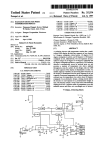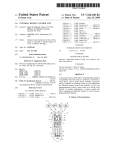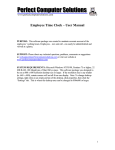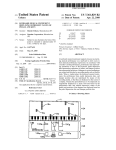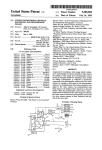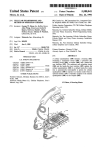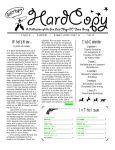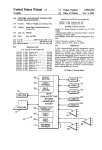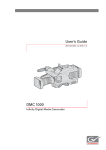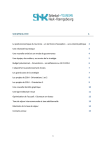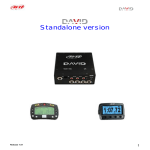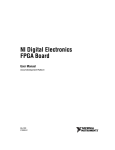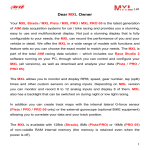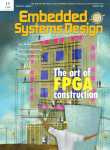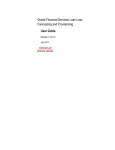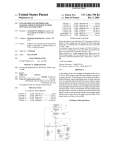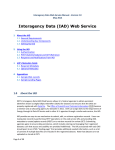Download T] .1
Transcript
USOO5841051A Ulllted States Patent [19] [11] Patent Number: Segan [45] [54] [75] Date of Patent: 5,841,051 Nov. 24, 1998 APPARATUS FOR PROVIDING MUSICAL 5,011,412 4/1991 Rosenberg ............................ .. 434/227 INSTRUCTION 5,107,743 5,214,231 4/1992 Decker ...... .. 5/1993 Ernst et a1. ....... .. Inventor: 5,392,682 2/1995 McCartney-Hoy ................. .. 84/470 R NIarc H_ Segan, New York, N_Y_ [73] Assignee: M. H. Segan Limited Partnership, New York, NY [21] Appl. No.: 516,450 [22] Filed? 84/478 84/652 OTHER PUBLICATIONS VTech, Little Smart Magic Keys User Manual, From prod uct purchased befor Aug. 17, 1995, pp. 1—23. Primary Examiner—Michael L. Gellner Aug- 17, 1995 Assistant Examiner—Shih-yung Hsieh [51] Int. Cl? ................................................... .. G09B 15/00 ‘g’mmey; Agent) 0’ Firm—cohen> P°mani> Lieberman 8‘ [52] [58] US. Cl. ....................... .. 84/477 R; 84/485 R; 84/478 Field of Search ................................ .. 84/477 R, 478, Wane [57] 84/479 A, 485 R, 481, 470 R; 434/362, 323 365 227_233 ’ [56] ’ 8/1977 4,041,828 8/1977 Leonard 4,054,079 10/1977 Green _ _ _ _ _ _ _ sohler _ _ _ _ _ _ _ _ _ _ _ _ and shaped to receive a child’s hand. The hand pad has ?ve U-S- PATENT DOCUMENTS 5/1975 Gullickson .............................. .. 84/470 470407324 _ The preferred embodiment provides an electronic learning aid Which includes a housing having a hand pad that is siZed References Cited 3,885,490 ABSTRACT _ ?nger portions With each having a ?nger switch embedded therein that is positioned to be actuated by the child’s ?nger. indicator is mounFed in ‘F105? Proximity to 219d associated _ _ _ _ __ 84/478 With each ?nger portion to indicate the appropriate ?nger to 84/471 R be depressed on the hand pad. Akeyboard assembly, having _ _ _ _ __ 84/423 an abbreviated keyboard, is also mounted on the housing. A 84/478 4,203,345 5/1980 Collin et al- 84/478 4,465,477 8/1984 AvGavaar ............................. .. 434/233 4,480,521 11/1984 Schmoyer .............................. .. 84/1.28 light emitting diode is mounted directly beneath each White key so that each White key can be illuminated to indicate the appropriate key to be depressed Amicrocomputer having a Speech Synthesizer provides instruction to the Student and 4’516’465 controls the operation of the electronic learning aid. 4,061,072 12/1977 del Castillo .. 5/1985 Kam """""" " " 84/470 R 4,559,861 12/1985 Patty et al. 4,690,644 9/1987 Flanders et a1. 84/470 R 434/158 4,902,231 2/1990 Freer ..................................... .. 434/227 17 Claims, 8 Drawing Sheets I—-- [C ‘B 350 2] llH2 360 I] 2H / I T] .1] [1]‘ [il -[l [l -T ‘ml I 2100 IC 2l0€ 200 / U.S. Patent Nov. 24, 1998 Sheet 1 of8 5,841,051 H10 Z|"‘Ol2b0CZIOC ‘‘1 r 2 2, \_ U.S. Patent Nov. 24, 1998 F/G. lB Sheet 2 of8 5,841,051 U.S. Patent Nov. 24, 1998 d*_il ll“ NU Sheet 3 of8 M HM 5,841,051 ||||| U.S. Patent Nov. 24, 1998 Sheet 4 of8 5,841,051 U.S. Patent Nov. 24, 1998 Sheet 5 of8 5,841,051 U.S. Patent Nov. 24, 1998 Sheet 6 of8 5,841,051 221mZloi 2l0gl0h210k II “1. 9m U.S. Patent Nov. 24, 1998 Sheet 8 of8 5,841,051 "a a8 5,841,051 1 2 APPARATUS FOR PROVIDING MUSICAL INSTRUCTION be depressed on the hand pad. Akeyboard assembly, having an abbreviated keyboard, is also mounted on the housing. A light emitting diode is mounted directly beneath each White BACKGROUND OF THE INVENTION key so that that each White key can be illuminated to indicate The present invention relates generally to a system and method for instruction in the operation of a keyboard musical instrument and speci?cally to a system that provides instruction as to the correct key ?ngering and key selection the appropriate key to be depressed. A microcomputer having a speech synthesiZer controls the operation of the electronic learning aid and provides instructions to the student. The electronic learning aid has a number of modes of of a keyboard musical instrument such as a piano, organ, or 10 reed-organ. Most people typically require a great deal of training to learn to play a keyboard instrument. Most young children, hoWever, have a very short attention span Which makes lengthy lessons and practice sessions very dif?cult for most children to endure. In addition, young children often do not 15 have the hand dexterity to perform the key manipulations required for pro?cient playing. Furthermore, as young chil the child successfully completes these exercises, he is instructed to move to the keyboard and to depress the dren normally do not have any previous musical education or experience, they are also hampered by not knoWing hoW illuminated keys With the appropriate ?nger as instructed. Throughout the instruction, the electronic learning aid pro to read musical notes. In summary, instruction of keyboard musical instruments is often very frustrating for both the adult instructor and child student. Several devices that provide instruction in the playing of keyboard musical instruments have been proposed that vides verbal reinforcement as to the correctness or incor rectness of the child’s response. BRIEF DESCRIPTION OF THE DRAWINGS 25 FIG. 1A is plan vieW of an electronic learning aid employ provide solutions to some of these problems. US. Pat. No. 5,107,743 to Decker discloses a piano teaching device having a panel designed to ?t over the keys of an existing keyboard so that lights mounted on the panel are located ing the principles of the present inventions FIG. 1B is a cross sectional vieW of the electronic learning aid of FIG. 1A taken along line IB—IB. directly above the piano keys. The lights illuminate to FIG. 1C is a cross sectional vieW of the electronic learning indicate the appropriate keys to be depressed and have more aid of FIG. 1A taken along line IC—IC. than one color to indicate the hand the user Will use to FIG. 1D is a partial cross sectional vieW of the electronic depress the keys (e.g., red for the left hand and green for the right hand). A card, Which provides data corresponding to a song to be played, is inserted into a card reader and the speed of the song is controlled by the user With a foot pedal. The device disclosed in Decker has the ability to indirectly operation. For beginners, the electronic learning aid instructs the child to use the hand pad and to depress the ?nger that is associated With the illuminated indicator. This exercise enhances hand dexterity and alloWs the child to associate a number from one through ?ve With each ?nger. Gradually, the exercises become more dif?cult until the child is depress ing the same ?ngers that are necessary to play a song. When learning aid of FIG. 1A taken along line IC—IC With the keys depressed. 35 indicate proper ?nger placement by illuminating indicators in a third color to indicate the position of the thumb on one side and little ?nger on the other side from the keys to be played. Although this device provides instruction as to FIG. IE is a right side vieW of the electronic learning aid of FIG. 1A. FIG. 2 is a perspective vieW of the electronic learning aid of FIG. 1. FIG. 3 is a plan vieW of the hand pad of the electronic learning aid of FIG. 1. FIG. 4 is a schematic representation of the microcomputer of the electronic learning aid of FIG. 1. ?ngering, this instruction is more suitable for adults Who can more quickly identify the appropriate ?nger to be used based on the position of the thumb and little ?nger. Furthermore, FIG. 5 is a front vieW of card usable in conjunction With this device provides no detection or feedback as to the 45 the electronic learning aid of FIG. 1. correct ?nger placement. Another device disclosed in US. Pat. No. 4,480,521 to DETAILED DESCRIPTION Schmoyer instructs the student in the proper ?ngering for The preferred embodiment of the present invention is an chord triads on an organ or piano. Indicators on a hand display illuminate to indicate the proper ?ngers for use in electronic learning aid, having a speech synthesiZer, that playing the chord. In addition, a number (indicating the appropriate ?nger) is illuminated on the keys of a keyboard provides instruction as to the playing of a piano With an abbreviated keyboard and a hand pad siZed and shaped to receive a child’s hand. Each key of the keyboard can be display to indicate the proper ?nger placement and key selection. HoWever, the invention described in Schmoyer selectively illuminated to indicate the appropriate key selec does not provide feedback or reinforcement as to ?nger 55 tion to the child. The hand pad has ?ve ?nger portions (the placement. thumb being considered a ?nger throughout this discussion) With each ?nger portion having a manually actuable ?nger SUMMARY OF THE INVENTION sWitch disposed therein. An indicator is disposed in close proximity to each ?nger portion. The draWbacks of the prior art are overcome by the method and apparatus of the invention. The preferred embodiment provides an electronic learning aid Which includes a housing having a hand pad that is siZed an shaped to receive a child’s hand. The hand pad has ?ve ?nger portions With each having a ?nger sWitch embedded therein that is positioned to be actuated by the child’s ?nger. An indicator is mounted in close proximity to and associated With each ?nger portion to indicate the appropriate ?nger to The electronic learning aid begins at an extremely easy level of instruction and provides increasingly difficult tasks. For example, the electronic learning aid begins by having 65 the child place his hand in the hand pad and actuate each ?nger sWitch in successive order While providing a visual indication of the sWitch to be depressed by illuminating each indicator successively. The device also produces an audible output to the child to indicate the ?nger to be depressed so 5,841,051 3 4 as to associate a number (from one through ?ve) With each the eight short keys 211 are the sharp and ?at keys normally ?nger. Next, the child Will be tasked to actuate each ?nger sWitch as the electronic learning aid randomly illuminates each indicator and audibly requests the child to depress the are eight short 211 and tWelve long keys 210a—l for total of associated With a conventional keyboard. In summary, there tWenty keys each of Which is actuatable over a range of ?nger sWitch (by audibly producing the corresponding ?nger motion (as shoWn in FIGS. 1C—D) like that of. Keyboard assembly 200 also includes tWelve LEDs D1—D12 (Which numbers one through ?ve). These exercises develop hand dexterity in the child and provide reinforcement of the number associated With each ?nger. are schematically represented in FIG. 4) Which are mounted on a printed circuit board beneath keys 210a—l so that each After successfully mastering the previously discussed exercises, the child Will be tasked to depress the ?nger 10 sWitches as each associated indicator is illuminated. The electronic learning aid Will illuminate the indicators of the hand pad so that the child uses each ?nger in the same sequence as he Would if he Were playing a particular song on the keyboard. As the child depresses each ?nger sWitch, the 15 corresponding note from the selected song is produced to provide audible reinforcement of the ?nger actuation With the note of the song. In addition, this exercise provides muscle memory of the appropriate ?ngers to be used for the With the song and measured music (a staff) illustrating the notes of the song imprinted on the face of the card. A particular song. number, corresponding to the ?nger that should be used to play the note, is printed directly above each note. Each card has tWo faces, With each face having a unique song and graphic indicia imprinted thereon. Each card 400 includes a Each subsequent task becomes slightly more dif?cult With the child moving from the hand pad to the keyboard With the increasing dif?culty. The electronic learning aid provides unique permutation of punched holes 405 along the middle aural and visual instructions and feedback as the child progresses through the various skill levels. As illustrated in FIGS. 1A—E and FIG. 2, the preferred embodiment of the present invention, an electronic learning aid 1, includes a housing 2 Which has a hand pad 100, a keyboard assembly 200, a card reader 300, and card support key 210a—l has an associated LED D1—D12 disposed imme diately therebeneath as shoWn in FIG. 1C. Each key 210a—l is formed from molded plastic, is someWhat holloW in construction, and is light in color so as to be easily illumi nated by its associated LED D1—D12. Electronic learning aid 1 is provided With cards 400 Which are inserted into card slot 360 (described beloW) on card support 350. Referring to FIG. 5, each card face of each card 400 corresponds to a song and has graphic indicia associated 25 of the bottom edge of card 400. Card support 350, Which is positioned in the rear portion of housing 2, includes a main support 351 and a pair of card retainers 355 Which de?ne a card slot 360. Card slot 360 is siZed and shaped to ?rmly hold an inserted card 400 in place. Card reader 300, Which is a conventional card reader having 350. A microcomputer 500 (shoWn schematically in FIG. 4)is disposed in housing 2. four mechanical ?ngers 305 in the preferred embodiment, is Hand pad 100 is mounted in the front right portion of housing 2 and is siZed and shaped to receive a child’s right hand. Referring to FIG. 3, hand pad 100 includes a palm portion 107 and ?ve ?nger portions 101—105. Hand pad 100 positioned in front of the base of card support 350 so that mechanical ?ngers 305 detect the permutation of punched 35 is mounted to housing 2 so that the upper surface of palm portion 107 and ?nger portions 101—105 are slightly higher than the surrounding housing surface. Each ?nger portion 101—105 includes a manually actuatable ?nger sWitch 121—125 positioned near the end of the respective ?nger portion 101—105 for actuation by the child’s ?nger tip and can be any suitable conventional sWitch. As shoWn best in FIG. 1B, ?nger portion 103, as Well as the other ?nger portions 101,102, 104, and 105, pivots With respect to palm 45 portion 107 at a living hinge to actuate ?nger sWitch 123. instrument or music source. Microcomputer 500, Which is shoWn schematically in FIG. 4, includes U1 Which is a speech synthesiZer chip Hand pad 100 (palm portion 107 and ?nger portions 101—105) is formed from molded plastic and is overlaid With having the capability of generating intelligible audible speech through speaker 505. A suitable speech synthesiZer a vinyl protective covering. chip is sold by Texas Instruments, Inc. of Dallas, Tex., as part number TSP50C19. U1 includes programmable ROM Which is stores the speech and songs produced by micro computer 500. Speaker 505 is mounted slightly rearWard of Five ?nger indicators 111—115 are mounted on housing 2 With one being positioned near the end of each of ?ve ?nger portions 101—105 of hand pad 100. Each ?nger indicator 111—115 is mounted in an indicator housing 116 so that the indicator is positioned above the surrounding surface of housing 2. By mounting indicators 111—115 in a pronounced position up off the surface of housing 2, indicators 111—115 holes 405 along the bottom of card 400 that has been inserted into card slot 360 of card support 350. Six control buttons 11—16 are mounted to housing 2 and are conventional push actuated sWitches. PoWer button 16 toggles electronic learning aid 1 on and off. Control buttons 11—14 are mode buttons Which control the mode of operation of electronic learning aid 1 and include a Keys One Mode button 11, a Keys TWo Mode button 12, a Player Piano Mode button 13, and a Free Play Mode button 14. Scroll button 15 is also provided to control the identity of the simulated hand pad 100 in housing 2. Microcomputer 500 is poWered 55 by four C cell batteries Which are housed in a battery compartment that opens from the bottom side of housing 2. are not obstructed by the child’s hand Which rests on PoWer button 16 is represented schematically by S36, upraised hand pad 100 during use. Indicators 111—115 of the Which acts to toggle U1 on and off When actuated. Keys preferred embodiment are Light Emitting Diodes (LEDs), (210a—l and 211) are represented by sWitches S1—S20 With S1 being the far left key 210a (“A”) and S20 being the far but could be any suitable visual indicator. right key 2111 (“E”). SWitches S21—S25 represent ?nger Keyboard assembly 200 includes an abbreviated key board having tWelve long keys 210a—l. Keys 210a—l of keyboard assembly 200 are con?gured in a conventional U.S. keyboard arrangement With key 210a, located at the far left of keyboard assembly 200, being an “A” key and key 2101, located at the far right of keyboard assembly 200, being an “E” key. As those skilled in the art of music know, 65 sWitches 121—125, respectively. Mechanical ?ngers 305 are represented by sWitches S31—S34, While control buttons 11—15 are represented by sWitches S26—S30. LEDs D1—D12 are mounted under keys 210a—l, respectively. Finger indi cators 111—115 are represented schematically by LEDs D13—D17. LEDs D18—D21 are not used in the preferred 5,841,051 5 6 embodiment, but could be used to construct a metronome in a second embodiment discussed below. imparted by the key dissipates. The decay of the note Will take longer if the key is held doWn by the user and Will occur more quickly if the user releases the key. As Will be discussed in more detail beloW, the child Will U1 controls the operation of microcomputer 500. To illuminate an LED (D1—D21), the transistor Q8—Q10 cor responding to the roW of the selected LED and the transistor Q1—Q7 corresponding to the column of the selected LED are simultaneously turned on. SWitches S1—S34 are read by a conventional scanning procedure by U1 , Which provides a sequential TTL 5 Volt output on lines PAO through PA4 so that only one roW of sWitches S1—S34 is supplied With poWer be repeatedly instructed to depress a particular ?nger sWitch 121—125 or key 210a—l. In the preferred embodiment, the note corresponding to ?nger sWitch 121—125 or key 210a—l Will sound for a predetermined duration at Which time electronic learning aid 1 Will terminate the audible output of 10 register), Which are connected to the columns of sWitches S1—S34. Therefore, U1 identi?es the sWitch that is depressed by identifying the column and roW of the sWitch that is alloWing a voltage to pass therethrough. normal keyboard by increasing the speed of the decay of the 15 Operation As discussed above, to turn on electronic learning aid 1 Keys One Mode Will be produced in audible intelligible form through speaker When Keys One Mode button 11 is actuated or after start 25 up, electronic learning aid 1 Will enter the Keys One Mode. This mode alloWs the child to associate each ?nger With a ?nger number and a note. Electronic learning aid 1 Will begin by saying “Put your hand in mine. Remember, each ?nger has a number. Your thumb is ?nger one. Your little aid 1 provides audible instruction to the child to use a particular ?nger to depress a key or ?nger sWitch. Consequently, each ?nger of the right hand is represented by a number With the thumb being a one, the index ?nger a tWo, the middle ?nger a three, the ring ?nger a four, and the little ?nger a ?ve. To spare the reader from the tediousness of repetition, a note. The predetermined duration of the notes is arbitrary for the exercises in hand dexterity and ?nger association. HoWever, When the child is learning a song, each note Will have a predetermined duration (e.g., half notes, quarter notes, etc.) that is associated With that particular note of the song. the child depresses poWer button 16. Microcomputer 500 Will then poWer up and generate synthesiZed speech Which 505 (for ease of discussion hereinafter “say”) and With the Words “Hi! Let’s play the piano.” At this point, electronic learning aid 1 Will immediately enter Keys One Mode. If no buttons are depressed for a predetermined period of time, electronic learning aid 1 turns itself off. In many of the modes discussed beloW, electronic learning the note even if the child has not released ?nger sWitch 121—125 or key 210a—l. HoWever, if the child releases ?nger sWitch 121—125 or key 210a—l before the predetermined time has elapsed, electronic learning aid Will simulate a at a time. During this sequential scanning, U1 constantly monitors the inputs of U2 (Which is a conventional shift 35 reWard phrase Which is “said” by electronic learning aid 1 at the successful completion of each task Will sometimes be omitted during the discussion beloW. The reWard phrases in ?nger is ?nger ?ve. Each time a light is lit, press that ?nger doWn. As We play, I’ll tell you the ?nger numbers. Okay, let’s go. FolloW the lights. Finger one.” At this time, microcomputer 500 Will illuminate ?nger indicator 111 to provide a visual indication along With the audible instruction to the child to push his thumb doWn. When microcomputer 500 detects the actuation of ?nger sWitch 121, electronic learning aid 1 Will momentarily sound a “C” note through speaker 505, turn off ?nger indicator 111 and say “Finger tWo” and illuminate ?nger indicator 112. Upon the success ful actuation of ?nger sWitch 122, electronic learning aid 1 the preferred embodiment include the folloWing phrases: Will sound a “D” note and move to ?nger three and so on “Good.” until reaching ?nger ?ve While sounding an “E” note for ?nger three, a “F” for ?nger four, and a “G” for ?nger ?ve. “That sounds great.” After successfully actuating ?nger sWitch 125 (corresponding to ?nger ?ve), electronic learning aid 1 Will “Good job.” “That’s great.” 45 Similarly, electronic learning aid 1 uses a number of correction phrases When the child actuates an incorrect ?nger one in this same manner and sounding the same corresponding notes through speaker 505 upon the actuation of the correct ?nger sWitch 121—125. After successfully completing this task, electronic learning aid 1 Will say “Sets sWitch. In the preferred embodiment, these phrases include: “Oops, Watch the lights.” “Careful, Watch the lights.” play it again.” The device Will then have the child perform the exact same task of depressing each successive ?nger doWnWard to actuate each successive ?nger sWitch 121—125 in both Finally, to indicate to the child that a neW or different task is about to begin, electronic learning aid 1 has a number of transitory phrases Which include: “Let’s try something neW.” successively task the child to exercise each ?nger starting With ?nger ?ve and descend from ?nger ?ve doWn through 55 “Let’s try the next one.” “Let’s learn the next one.” “Let’s try this one.” ascending and then descending order. HoWever instead of identifying the appropriate ?nger to be used as “Finger one” or “Finger tWo” as described above, electronic learning aid 1 simply says the number corresponding to the ?nger to be depressed. For example, electronic learning aid 1 Would “Let’s learn something neW.” simply say “One, tWo, three, four, ?ve, ?ve, four, three, tWo, “Let’s try another song.” (If appropriate.) “Let’s learn another song.” (If appropriate.) one” as the child successfully actuates each ?nger sWitch As those educated in music knoW, the length of time that indicator 111—115 is also illuminated While electronic learn ing aid 1 says its associated ?nger number and each note is sounded upon the actuation of correct ?nger sWitch a note is sounded is very important to the successful pro duction of a musical compilation. With a normal piano keyboard, a note is sounded at the actuation of a key and the note Will gradually decay as the energy in the piano string 121—125, quickening the pace of instruction. As above, each 65 121—125. After successfully completing this task, electronic learning aid 1 Will audibly produce a reWard phrase such as 5,841,051 7 8 “Good job.” followed by a transitory phrase such as “Let’s try something neW.” right hand. Electronic learning aid 1 Will then begin With a basic task and say “FolloW the lights. One, tWo, three, four, Electronic learning aid 1 Will then say “One” and illumi nate ?nger indicator 111. The device Will then Wait for the actuation of ?nger sWitch 121 and then produce a “C” and ?ve, ?ve, four, three, tWo, one, one, tWo, three, four, ?ve, ?ve, four, three, tWo, one.” While illuminating each key 210a—g in sequential order and producing the appropriate say “One” again While illuminating ?nger indicator 111. After the child correctly depresses ?nger sWitch 121 again, musical note as the child depresses each key. the device Will sound a “C” note and again say “One” and 1 Will produce a “C” and say a reWard phrase such as “That’s ing aid 1 Will then say “Let’s play Mary Had a Little Lamb again. Listen. First I’ll play it.” at Which time the device Will play Mary Had a Little Lamb. Electronic learning aid 1 Will then instruct the child to play the song by saying “NoW you great,” folloWed by “Listen, you repeated the same note.” play it. FolloW the lights.” and Will illuminate keys 210c—g illuminate ?nger indicator 111. When the child depresses ?nger sWitch 121 for the third time, electronic learning aid After successfully completing this task, electronic learn 10 Next, electronic learning aid 1 Will move to ?nger tWo and that are to be depressed to play Mary Had a Little Lamb say “TWo, tWo, tWo” While illuminating ?nger indicator 112. As the child correctly actuates ?nger sWitch 122 (corresponding to ?nger tWo) in response to each audible While simultaneously saying the ?nger number of the ?nger 15 to be used to depress the key. Speci?cally, electronic learn ing aid 1 Will say “Three, three, tWo, one, tWo, three, three, prompt, electronic learning aid 1 Will sound a “D” note. Electronic learning aid 1 Will then move on to ?nger three three, tWo, tWo, tWo, three, ?ve, ?ve, three, tWo, one, tWo, three, three, three, three, tWo, tWo, three, tWo, one.” While and so on up through ?nger ?ve. After successfully depress illuminating the appropriate key 210c—g. ing ?nger ?ve doWn three times, electronic learning aid 1 After completing this task, the device Will randomly Will say a reWard phrase such as “Terri?c,” folloWed by a transitory phrase such as “Let’s try the neXt one.” select a different song and task the child to folloW the Electronic learning aid 1 Will then similarly task the child to actuate combinations of ?ngers such as “TWo, three, tWo, three, tWo, three, tWo” folloWed by “TWo, four, tWo, four, tWo, four, tWo, four, tWo” and then “One, ?ve, one, ?ve, one, ?ve, one, ?ve, one.” In each of these tasks, electronic learning aid 1 Will illuminate the appropriate indicator, aWait actuation of the appropriate ?nger sWitch, and sound the respective note. After the completion of each these tasks electronic learn ing aid 1 Will provide a reWard phrase and say “Let’s play a game. Let’s play Without the lights. I’ll tell you the numbers.” The device Will then say each number “One, tWo, three, four, ?ve, ?ve, four, three, tWo, one,” Without illumi nating ?nger indicators 111—115, but While still aWaiting the illuminated keys While saying the ?nger to be used to depress the key. The child Will be tasked to successfully complete ten songs before this mode is ?nished at Which 25 appropriate key 210, but not providing audible instructions as to the ?nger to be used. Keys TWo Mode Pressing Keys TWo Mode button 12 alloWs electronic 35 child’s correct response and producing the musical note associated With each ?nger sWitch 121—125. Electronic learning aid 1 Will then provide a reWard phrase and ran learning aid 1 to enter the Keys TWo Mode. When the device enters the Keys TWo Mode, electronic learning aid 1 Will say “Let’s play the piano. Move your hand to the keys that are lit.” at Which time keys 210c—g Will illuminate to indicate to the child the correct placement of the right hand. The device Will continue by saying “Remember, each ?nger has a number. Your thumb is ?nger one. Your little ?nger is ?nger domly generate ten ?nger numbers (Without using any ?ve. Each time a light is lit, press that ?nger doWn. As We number more than tWice) Which are similarly tasked to the child to actuate Without the aid of ?nger indicators 111—115. After successful completion by the child, the device Will task the child to play a song by saying “Let’s play Mary Had a Little Lamb. Listen. First, I’ll play it.” Electronic learning time electronic learning aid 1 operate in Keys TWo Mode. In a variation of the preferred embodiment, another eXercise alloWs the child to play the song While illuminating the play, I’ll tell you the ?nger numbers. Okay, let’s go. FolloW the lights. Finger one.” At this time, microcomputer 500 Will illuminate key 2106 to provide a visual indication along With 45 the audible instruction to the child to push doWn ?nger one aid 1 Will then audibly produce (hereinafter “play”) the song (his thumb). When microcomputer 500 detects the actuation of key 2106, electronic learning aid 1 Will momentarily “Mary Had a Little Lamb” and then say “NoW you play it. sound a “C” note through speaker 505, turn off (remove the FolloW the lights.” By playing the song before alloWing the illumination from) key 2106, and say “Finger tWo” and illuminate key 210d. Upon the successful actuation of key child to play the song, the timing of the song is demonstrated for the child. The device Will then sequentially illuminate the ?nger indicators corresponding to the proper ?ngering that 210d, electronic learning aid 1 Will sound a “D” note and move to ?nger three and so on until reaching ?nger ?ve. should be used When playing the song on a keyboard. In After successfully actuating key 210g (corresponding to addition, electronic learning aid 1 Will say the ?nger number of each ?nger to be pushed doWnWard by the child and produce the corresponding note of the song “Mary Had a Little Lamb.” More speci?cally, electronic learning aid 1 Will say “Three, three, tWo, one, tWo, three, three, three, tWo, 55 ?nger one in this same manner and sounding the same notes (“C, D, E, F, and G) corresponding to keys 210c—g. After successfully completing this task, electronic learning aid 1 Will say “Lets play it again.” tWo, tWo, three, ?ve, ?ve, three, tWo, one, tWo, three, three, three, three, tWo, tWo, three, tWo, one.” While illuminating corresponding ?nger indicators 111—115. The device Will then have the child perform the eXact same task of depressing each successive ?nger doWnWard to When the child successfully completes the song the device Will say “That sounds great. NoW let’s play on the keys. Move your hand to the keys that are lit.” At this point in time, keys 210c—g (corresponding to the musical notes “C, D, E, F and G”, respectively) Will be illuminated by LEDs D3—D7 to indicate to the child the placement of his ?nger ?ve and the “G”), electronic learning aid 1 Will successively task the child to exercise each ?nger starting With ?nger ?ve and descend from ?nger ?ve doWn through 65 actuate each successive key 210c—g in both ascending and then descending order. HoWever instead of identifying the appropriate ?nger to be used as “Finger one” or “Finger tWo” as described above, electronic learning aid 1 simply says the number corresponding to the ?nger to be depressed. 5,841,051 9 10 For example, electronic learning aid 1 Would simply say “One, tWo, three, four, ?ve, ?ve, four, three, tWo, one.” as the child successfully actuated each key 210c—g. As above, each key 210c—g is also illuminated While electronic learning aid ?ve, one, ?ve, one.” While illuminating key 2106 While saying each “one” and illuminating key 210k While saying each “?ve”. After successfully completing this task, electronic learn 1 says its associated ?nger number and each note is sounded upon the actuation of the respective key 210. After success ing aid 1 Will provide an exercise that tasks the child to move his hand even further. The device Will say “NoW let’s learn fully completing this task, electronic learning aid 1 Will something neW. One, tWo, three.” While illuminating the audibly produce a reWard phrase such as “Good job.” folloWed by a transitory phrase such as “Let’s try something respective keys 210c—e and playing the respective notes (“C, neW.” 10 Electronic learning aid 1 Will then say “One” and illumi nate key 210C. The device Will then Wait for the actuation of key 2106 and then produce a “C” and say “One” again While four, ?ve.” Which instructs the child to move his thumb under the most recently used ?nger, Which is ?nger three, to depress illuminated key 210f (“F”), and to the continue illuminating key 210C. After the child correctly depresses key 2106 again, the device Will sound a “C” note and again say “One” and illuminate key 210C. When the child D, and E”) as the child depresses each key. Electronic learning aid 1 Will then say “Thumb under. One, tWo, three, depressing keys 210g—j (notes “G, A, B, and C”, 15 respectively) (Which are sequentially illuminated as the ?nger number is audibly produced) With ?ngers tWo through depresses key 2106 for the third time, electronic learning aid great,” folloWed by “Listen, you repeated the same note.” ?ve. After completion, the child Will have used ?ve ?ngers to play a scale of eight notes on the keyboard corresponding to keys 210c—j. This exercise is repeated to ensure that the Next, electronic learning aid 1 Will move to ?nger tWo and child has mastered this neW skill. say “TWo, tWo, tWo” While illuminating key 210d. As the child actuates key 210d (corresponding to ?nger tWo) in response to each audible prompt, electronic learning aid 1 Next, the child Will be tasked to play a song that requires the use of this neW skill. Speci?cally, electronic learning aid 1 Will say “Let’s play TWinkle TWinkle Little Star. Listen. 1 Will produce a “C” and say a reWard phrase such as “That’s Will sound a “D” note, Which corresponds to key 210d. Electronic learning aid 1 Will then move on to ?nger three and so on up through ?nger ?ve. After successfully depress 25 ing key 210g three times, electronic learning aid 1 Will say a reWard phrase such as “Terri?c.” folloWed by a transitory phrase such as “Let’s try the next one.” Electronic learning aid 1 Will then similarly task the child to actuate combinations of ?ngers such as “TWo, three, tWo, three, tWo, three, tWo.” folloWed by “TWo, four, tWo, four, tWo, four, tWo, four, tWo.” and then “One, ?ve, one, ?ve, one, ?ve, one, ?ve, one.” In each of these tasks, electronic learning aid 1 Will illuminate the appropriate key, aWait First, I’ll play it.” after Which the song Will be played. By playing the song before alloWing the child to play the song, the timing of the song is demonstrated for the child. The device Will then say “NoW you play it. FolloW the lights. Use the right ?ngers.” and then illuminate the correct keys 210c—j While saying the ?nger number of the ?nger to be used to depress the key. After completing this task, the device Will randomly select a different song and task the child to folloW the 35 illuminated keys While saying the ?nger number of the ?nger to be used to depress the key. If the child performs another song correctly, the child Will be given the opportu actuation of that key, and sound the associated note before prompting the child for the next key. After successful completion by the child, the device Will task the child to play a song by saying “Let’s play Mary Had a Little Lamb. First, I’ll play it.” Electronic learning aid 1 Will then play the song “Mary Had a Little Lamb” and then say “NoW you play it. FolloW the lights.” By playing the song before alloWing the child to play the song, the timing nity to decide Which song to play. The device Will say “To play another song, put in that card.” As discussed above, microcomputer 500 Will identify inserted card 400 by detect ing the permutation of holes 405 along the bottom edge of card 400. This identi?cation process can be accomplished by of the song is demonstrated for the child. The device Will card is inserted, electronic learning aid 1 Will say “Let’s play” folloWed by the name of the song and then “Listen. First I’ll play it.” at Which time the song corresponding to the card Will be played. The device Will then task the child to any suitable method such as correlating the various combi nations of punched holes to memory addresses Which cor respond to a ROM table that stores the song data. After a then sequentially illuminate keys 210c—g in the appropriate order to properly play the song. In addition, electronic learning aid 1 Will say the ?nger number of each ?nger to be pushed used by the child to depress the illuminated key and produce the corresponding note of the song “Mary Had a Little Lamb.” More speci?cally, electronic learning aid 1 play the song by saying “NoW you play it. FolloW the lights. Use the right ?ngers.” Which is folloWed by the illumination of the appropriate keys 210a—l and identi?cation of the Will say “Three, three, tWo, one, tWo, three, three, three, tWo, tWo, tWo, three, ?ve, ?ve, three, tWo, one, tWo, three, three, three, three, tWo, tWo, three, tWo, one.” While producing the melody of Mary Had a Little Lamb as the child presses the correct keys 210c—g. 55 Up until this point in instruction, the child has not had to move his hand along the keyboard since the exercises and song played is appropriately played With the hand in ?xed position With respect to the keyboard. In other Words, the combinations of musical notes played have spanned only over ?ve keys 210c—g. HoWever, the next exercise requires Player Piano Mode the child to move his hand slightly. Electronic learning aid 1 Will task the child to use ?ngers one and ?ve to depress keys 2106 (“C”) and 210k (“A”), respectively, Which are ?ve keys apart. For example, the device Will say “Remember, folloW the lights. One, ?ve, one, appropriate ?ngering as discussed above. If the child completes this song, the child is prompted to select another song by inserting a different card. If the child does not remove the card Within eight seconds, the device Will say “Let’s play” folloWed by the name of previous song “again.” Should this occur, electronic learning aid 1 Will not ?rst play the song as above, but simply task the child to folloW the indicators and play it himself. 65 When Player Piano Mode button 13 is pressed, electronic learning aid 1 Will enter the Player Piano Mode in Which the device Will play the song associated With the inserted card. The mode begins With electronic learning aid I saying “Put in a card. I’ll play a song for you.” After the child inserts a card, the device Will say the name of the song and then play 5,841,051 11 12 it. When the song is ?nished, electronic learning aid 1 an electronic circuit coupled to said indicators to selec prompts the child for another card by saying “To play tively activate each of said indicators, activation of an indicator de?ning a selected ?nger portion and indicat ing to the user to move the user’s ?nger positioned in another song, put in that card.” the selected ?nger portion; and Free Play Mode When Free Play Mode button 14 is pressed, electronic learning aid 1 enters the free play mode Which has tWo submodes. If a card 400 is inserted in card support 350 When Free Play Mode button 14 is actuated, then electronic learning aid 1 Will illuminate the proper keys 210a—l to alloW the child to play the song on inserted card 400. If no card is inserted in card support 350 When Free Play Mode button 14 is actuated, then electronic learning aid 1 and keyboard assembly 200 act as a conventional electronic keyboard audibly producing the note corresponding to keys an output device coupled to said electronic circuit, Wherein said electronic circuit causes said output device to produce an output to indicate the ?nger to be 10 moved by the user in said selected ?nger portion. 2. The apparatus of claim 1, further comprising: an output device coupled to said electronic circuit; an actuator disposed in each of said ?nger portions, positioned for actuation by movement of the user’s ?nger, and coupled to said electronic circuit; 15 said electronic circuit determining Whether an actuator actuated by the user corresponds to the selected ?nger portion; and 210a—l that are depressed by the child. said electronic circuit causing said output device to output Scroll Button an error output When the user actuates an actuator not corresponding to the selected ?nger portion. By actuating scroll button 15, the child can scroll through 3. The apparatus of claim 2, Wherein: a number of instruments and sounds that can become the said electronic circuit causes said visual indicators to source of the tones in place of a piano. For example, the piano tones might be replaced by an organ, a ?ute, a dog barking, or horn bloWing. This feature is accessible in Free Play Mode and Player Piano mode. activate in a predetermined sequence prompting the user to actuate said actuators disposed in said associ 25 said electronic circuit determines Whether said sequence of actuators corresponding to said sequence of activa tion of said visual indicators is actuated by the user and causes said output device to produce an output indica tive of the correctness of the user’s actuation of said Other embodiments While in the preferred embodiment of the present invention, the timing of the song is taught by terminating the production of each note as the song should be played, When the child holds the key or ?nger sWitch doWn too long. actuators. 5. The apparatus of claim 1, further comprising: a keyboard assembly coupled to said electronic circuit and having a plurality of actuatable keys, each of said keys HoWever, another method of teaching the timing Would be to use indicators 111—115 (or similarly LEDs under keys 210a—l) Which are multi-colored. For example, an indicator Would illuminate green to indicate that a key or ?nger sWitch should be depressed, and illuminate red to indicate that the key or ?nger sWitch should be released. Similarly, a metro nome could be provided to further illustrate timing. For example, a metronome Which is constructed of a series of having an indicator associated thereWith to selectively identify said key; and Wherein said electronic circuit selectively causes said indicator to identify said keys to prompt the user to actuate said keys. 6. The apparatus of claim 5, Wherein: said electronic circuit selectively causes said keys to illuminate in a predetermined sequence prompting the four LEDs might be horiZontally positioned directly above hand pad 100 and controlled by microcomputer 500. Each LED Would sequentially illuminate from left to right and user to actuate said keys in said same sequence. then from right to left to simulate the movement of a metronome. ated ?nger portions in said sequence. 4. The apparatus of claim 3, Wherein: 7. The apparatus of claim 6, Wherein said electronic 45 Although the indicators of the present inventions are LEDs, any suitable indicator such as conventional miniature light bulb Would Work equally as Well. Furthermore, although the present invention has been described in the context of an electronic learning aid Which teaches the child circuit causes said output device to produce an output to indicate the ?nger to be used by the user to actuate said illuminated keys. 8. The apparatus of claim 5, Wherein said electronic circuit causes said output device to produce an output to indicate the ?nger to be used by the user to actuate said instruction as to the melody using the right hand, another embodiment employing the principles of the present inven identi?ed keys. tion could be constructed to teach an adult or child the use instruments comprising: of the left hand in playing chords or melodies or could teach the student hoW to use both the right and left hands in playing musical instruments. Although the preferred 9. An apparatus for teaching a user to play a musical, a housing; 55 shaped pad having a palm portion and plurality of ?nger portions, each of said ?nger portions being siZed embodiment provides instruction for the playing of the piano, the present invention is equally suitable for teach and positioned to receive one of the user’s ?ngers; an actuator disposed in each of said ?nger portions, each said actuator being positioned to be actuated by the user With the user’s ?nger Without movement of the user’s hand When the user’s hand is disposed on said hand other keyboard instruments such as the organ. What is claimed is: 1. An apparatus for teaching a user to play a musical instrument, comprising: a hand-shaped pad having a palm portion and ?ve ?nger portions and being siZed and shaped to receive the user’s hand With one ?nger disposed in each of said ?nger portions; an indicator associated With each of said ?nger portions; a hand-shaped pad disposed on said housing, said hand pad; and 65 an indicator associated With each of said ?nger portions for indicating the actuator to be actuated and for indicating the ?nger to be used by the user to actuate said actuator. 5,841,051 14 13 providing a hand-shaped pad having a palm portion and ?ve ?nger portions and being siZed and shaped to 10. The apparatus of claim 9, further comprising: a keyboard assembly disposed in said housing, said key board having a plurality of actuatable keys, said keys receive the user’s hand, such that When the user’s hand is placed on the hand-shaped pad each of the user’s ?ngers is disposed Within a corresponding ?nger por being illuminatable; and an electronic circuit coupled to said keys for selectively tion; illuminating said keys. providing a plurality of ?nger sWitches in said hand pad and positioned to be actuated by the user’s ?ngers; 11. An apparatus for teaching a user to play a keyboard musical instrument, comprising: a plurality of manual input devices, each of said manual input devices being positioned to be actuated by one of the ?ve ?ngers of the user’s hand; providing an associated indicator With each of said ?nger 10 sWitches; activating an indicator to prompt the user to actuate said associated ?nger sWitch; and an output device for providing an audible output; and an electronic circuit coupled to said manual input devices providing an audible output to indicate the ?nder of the user to be used to actuate said ?nger sWitch. and said output device for causing said output device to produce an audible output to prompt the user to actuate 15. The method of claim 14, further comprising the steps one of said manual input devices, for indicating the of: determining Whether the user has actuated said ?nger sWitch associated With said activated indicator; and ?nger to be used by the user to actuate said one of said manual input devices, and for determining Whether the user actuated said one of said manual input devices. providing an error output When the user actuates a ?nger 12. The apparatus of claim 11, Wherein said electronic sWitch not associated With said activated indicator. 16. The method of claim 15, further comprising the steps circuit causes said output device to produce an output providing an indication as to the correctness of the user’s actuation. 13. The apparatus of claim 11, further comprising: a plurality of indicators, each of said indicators being of: providing an audible output to prompt the user to actuate 25 17. A method for teaching a user to play a keyboard associated With one of said manual input devices; musical instrument, comprising the steps of: providing a keyboard having a plurality of actuatable, illuminatable keys; selectively illuminating said keys of said keyboard to a hand-shaped pad having a palm portion and ?ve ?nger portions each of said ?nger portions being siZed and positioned to receive one of the user’s ?ngers, and having one of said manual input devices disposed in each of said ?ve ?nger portions; and electronic circuit causing said indicators to activate to indicate to the user the manual input device to be actuated. said ?nger sWitch associated With said activated indi cator. 35 indicate to the user Which of said keys to be actuated; and providing an audible output to indicate the ?nger of the user to be used to actuate said illuminated key. 14. A method for teaching a user to play a musical instrument, comprising the steps of: * * * * *

















